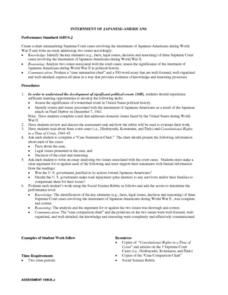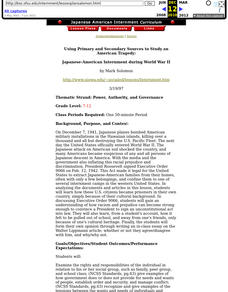Franklin D. Roosevelt Presidential Library & Museum
Pearl Harbor Activity #6: December 7 and September 11 - Infamy Twins?
Why did attackers on December 7, 1941, and on September 11, 2001, choose the targets they did? That is one of several questions young historians try to answer as they compare and contrast the two attacks. They also consider the...
Franklin D. Roosevelt Presidential Library & Museum
Pearl Harbor Activity #3: Public Opinion Word Cloud
As part of a study of the December 7, 1941 attack on Pearl Harbor, young historians imagine the feelings of those who lived during the attack by creating a word cloud of 10 words they think express the emotions of people at that time....
Curated OER
December 7, 1941 - Pearl Harbor
In this writing prompt worksheet, students learn that on December 7, 1941, the Japanese attacked Pearl Harbor in Honolulu, Hawaii. Students research five facts about the event using classroom resources and summarize the facts into their...
Curated OER
The Attack On Pearl Harbor: December 7, 1941
In this Pearl Harbor worksheet, students read about what happened on December 7th, 1941, read Roosevelt's speech in response, and complete activities in the passive voice about what they read. Students write the past participle of 10...
K12 Reader
What's the Purpose? FDR's Pearl Harbor Speech
FDR's December 7, 1941 address to the nation is the focus of a reading comprehension exercise that asks middle schoolers to read an excerpt from the Pearl Harbor speech and determine the president's purpose.
Franklin D. Roosevelt Presidential Library & Museum
Pearl Harbor Activity #1: Newspaper or Radio Account
After listening to President Franklin D. Roosevelt's "Day of Infamy" speech, young historians research information about the Japanese attack on Pearl Harbor, possible motives for the attack, and the consequences of the attack. Scholars...
Curated OER
Eye Witness Photos: Pear Harbor
The story goes that these photographs were found in an old camera, in an old footlocker that belonged to a real soldier, present at Pearl Harbor. These eye-witness pictures show the bombing of Pear Harbor from a soldier's perspective....
Curated OER
Pearl Harbor: December 7, 1941
In this crossword puzzle worksheet, students complete the crossword puzzle by solving the 13 clues at the bottom of the page. The theme of this worksheet is Pearl Harbor.
Curated OER
Internment of Japanese-Americans
Students assess the significance of a watershed event in the political history of the United States . They identify events and issues associated with the internment of Japanese-Americans as a result of the Japanese attack on Pearl Harbor...
Curated OER
Surprise at Pearl Harbor
Students review the concept of courage and relate it to their daily life. As a class, they are introduced to the events of December 7, 1941 at Pearl Harbor. Using a map, they locate Hawai'i and label the islands. They use the internet to...
Curated OER
Italian Enemy Aliens During World War II: Evacuation from Prohibited Zones
Students read and discuss the Enemy Alien Evacuation Order. They perform research by reading newspaper articles from February 1942 as well as investigating available information on the Internet. Students work in groups to create a...
Curated OER
A Day of Infamy:Analyzing FDR’s Pearl Harbor Address
In 1941 FDR spoke out on the events at Pearl Harbor. The class will get to analyze word choice, word meaning, author's craft and structure by analyzing an actual draft of this speech. They will look critically at the words used,...
Curated OER
The Aftermath
High schoolers examine photographs of the attack on Pearl Harbor. They discuss the damage that occured on December 7, 1941. They debate whether the attack was a success or not for the Japanese.
K12 Reader
The Attack on Pearl Harbor
After reading a short passage about Japan's involvement in World War II and why the Japanese attacked Pearl Harbor, readers are asked to analyze how the attack effected the attitudes of Americans who previously had not wanted to go to war.
Scholastic
Dear Miss Breed
This compelling plan based on the letters in the book Dear Miss Breed engages readers in learning what it was like for Japanese Americans following the attacks at Pearl Harbor. After reading the letters, young scholars will partake in...
Curated OER
Lost Names: Scenes From a Korean Boyhood,
What a great resource to share! Based on the book Lost Names by Richard Kim, this valuable lesson focuses on the Japanese occupation of Korea during WWII. Additionally, it employs first-person journaling as a mode of understanding themes...
Curated OER
Comma Exercise: Exercise 1
In an exercise from the Purdue Online Writing Lab, learners can review 11 rules for comma usage. They then either label 21 sample sentences C for correct as is, or they identify which rule of comma usage is being broken. Though the...
Stanford University
Japanese American Incarceration
Using documents, such as reports from government sources and civil rights activists, budding historians explore the justification for forcing hundreds of thousands of Japanese-Americans to leave their lives and re-evaluate that tragic...
Curated OER
Wives and Mothers in WWII
Eighth graders explore the effect of World War II from a financial standpoint. In this World History lesson, 8th graders review World War II through teacher lecture, reading and viewing pictures and cartoons, then discuss the hardships...
Curated OER
I'm Still Scared: The War Years
Young scholars read the story I'm Still Scared: The War Years, complete discussion questions, and activities about the book. In this war book lesson plan, students keep journals, write about being frightened, have a war veteran visit...
Curated OER
Japanese-American Internment during World War II
Learners write an in-class essay on whether they agree/disagree with Lippmann's article concerning Japanese-American internment
Curated OER
American Justice on Trial
Students role play a trial in which they consider if the United States government violated the rights of Japanese Americans after Pearl Harbor.
Curated OER
Letters from the Japanese American Internment
Young scholars explore the concept of Japanese internment. In this Japanese internment lesson, students examine primary sources that enable them to discover what internment camp life was like and its implications, Young scholars write...
Curated OER
Lesson III: Crisis, Pearl Harbor, Internment
The third in a series of lessons introduced by “A Fence Away From Freedom,” uses the Smithsonian website, “A More Perfect Union: Japanese Americans and the U.S. Constitution” and focuses on the section of the presentation devoted to the...

























